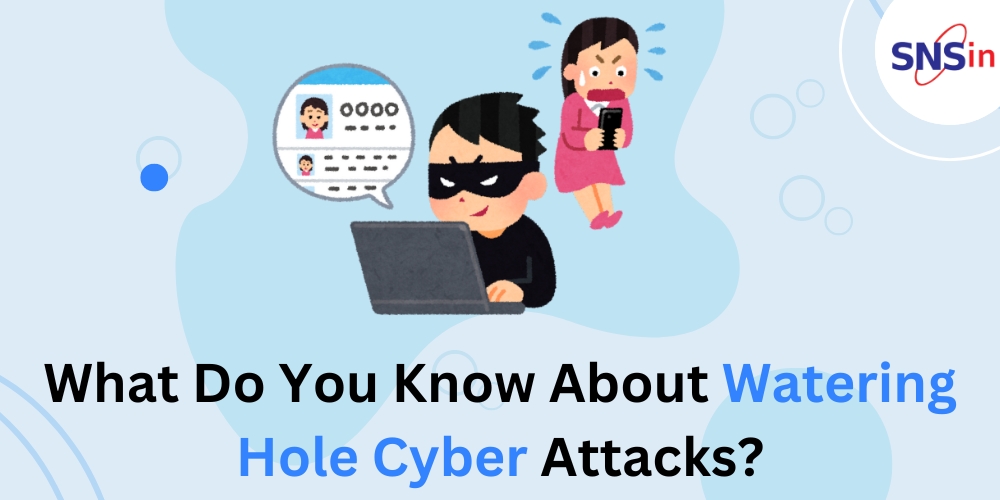Among the cybersecurity threats, the watering hole cyberattack is another complex and targeted action that cyber-gangs use to attack groups or organizations. Watering hole attacks are more selective, even targeting specific industries, companies or people.
This blog will elaborate on what watering hole attacks are, how they function and how to mitigate them.
What is a Watering Hole Attack?
Watering hole attack as the name suggests is a type of cyber-attack in which the attacker carefully selects a particular group and then compromises websites that any member of the particular group is likely to visit.
The source of the term “watering hole” is derived from big-game hunters. It means that one waits for the prey at the watering place, where animals are likely to gather to attack them. Likewise, cyber attackers plant malicious software on the website that their targets use commonly and then launch the site to get infected.
How Does a Watering Hole Attack Work?
Research and Reconnaissance
According to analysis, the initial stage of a watering hole attack is reconnaissance. Hackers recognize a target audience and study the websites that the audience uses most often. This could include trade associations, business newspapers and other credible online sources of information.
Website Compromise
After that, the attacker tries to find vulnerabilities in the intended websites that can be exploited. This may include exploiting poorly developed or out-dated applications, plug-ins, or other web app vulnerabilities. In case the attack is successful, the attacker is able to insert malicious code into the website.
Infection Delivery
The last step is when a member of the target group pays a visit to the website that has been infected with the malicious code. This code can take advantage of existing flaws in the visitor’s browser or plugin and infect the device with a virus. The malware could range from spyware, which tracks the activities of the user, to much worse such as ransomware or data theft Trojans.
Exploitation and Persistence
Once succeeded, the malware proceeds to collect information or execute other fraudulent things. The attacker may use this access to steal information, eavesdrop on communications, or create a foothold in the target network.
Why are watering hole attacks effective?
Targeted Approach
The watering hole attack targets specific groups or organizations, making it relatively selective. This makes it easier for the attackers to gain access to their target because they target websites that are familiar to the intended victims.
Stealth and Persistence
These attacks are usually hard to detect and can last for quite some time. Such sites are often genuine and reputable to the target audience, which will not arouse the suspicion of users of the site. Also, after penetrating the system, the malware can stay inactive and steal data for an extended period.
Leveraging Trust
This is because attackers take advantage of the fact that users automatically trust these websites. This trust makes users to easily be caught in the attack because they do not expect a site they trust with their information to be a source of malware.
How to Protect Against Watering Hole Attacks?
Regular Software Updates
All programs, including the OS, browsers, and plugins, should be updated regularly. Newer versions correct certain flaws and hence the system is less likely to be exploited.
Network Security Measures
Use strong network security features including a firewall, Web application Firewall , Authentication & identity Management, and intrusion prevention systems (IPS) etc. They can assist in identifying such processes and preventing their execution.
Cybersecurity Employee Training
Inform the employees of the existence of watering hole attacks and how to avoid them. Education is an essential strategy of cybersecurity, and people with knowledge are not easily deceived.
Antivirus and other security tools
Install multiple layers of security, such as antivirus and anti-malware products. These tools are capable of identifying and preventing execution of viruses or any other form of malware.
Regular Security Audits
Perform security assessment of your organization’s network and systems frequently. Learn about possible gaps to minimize the possibility of exploitation by intruders.
Segmentation and Least Privilege
Minimize the potential impact of infection by partitioning your network. Also, implement the principle of least privilege, guaranteeing users and applications have only the level of access sufficient to complete their tasks.
Monitor and Analyze Traffic
Continuously survey network traffic to distinguish abnormal behaviors. This can assist in early detection of activities such as watering hole attacks and other malicious activities.
Conclusion
Watering hole attacks can be described as a modern and highly targeted type of threat in the field of cybersecurity. So, by compromising trusted websites, the attackers can deliver the malware to the specific target groups very accurately. To avoid falling victim to a watering hole attack, it is crucial to identify how these attacks work and put in place the right security measures.
At SNS, we offer cybersecurity solutions to protect customers against threats. Send us your security related queries or requirements to [email protected]
Swathi
Author
Working IT professional and a Cyber Security enthusiast. Passionate to write about Cyber Security topics and Solutions. I share my insights as I study articles and trending topics in the field of Cyber Security.
![]()




